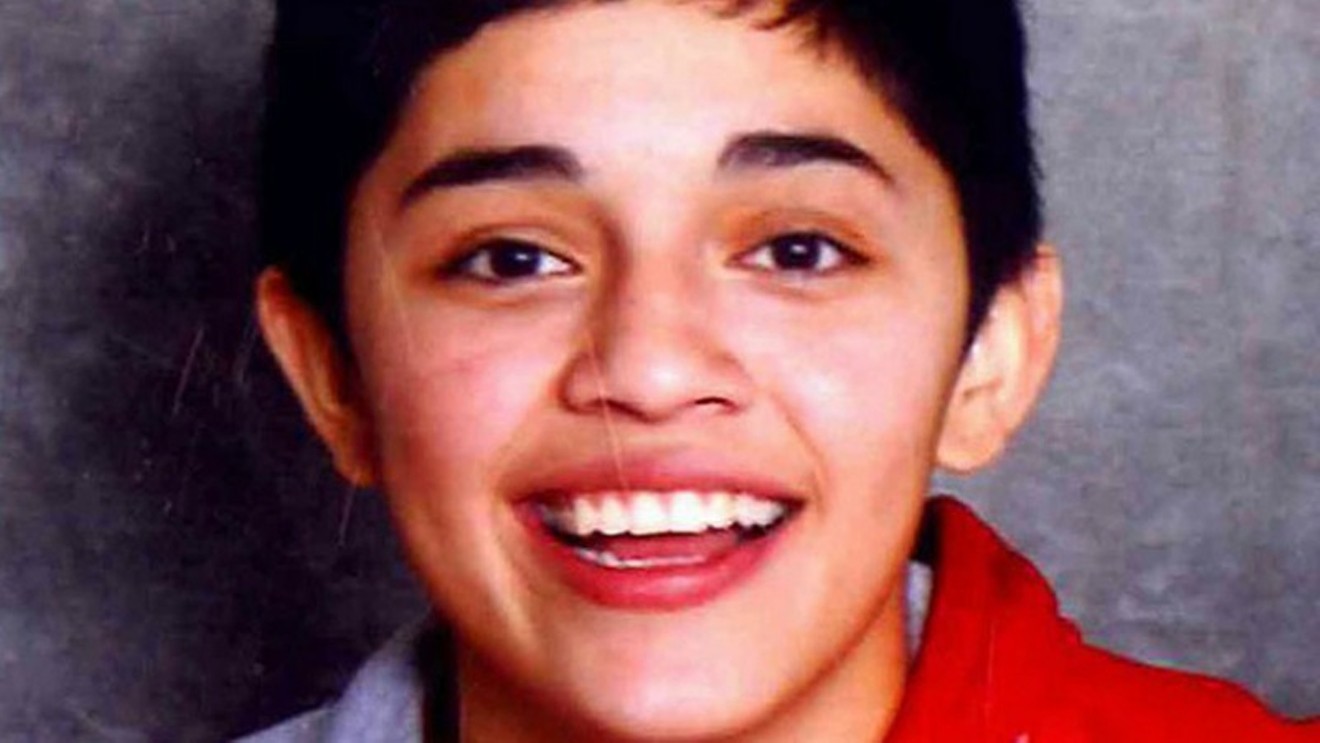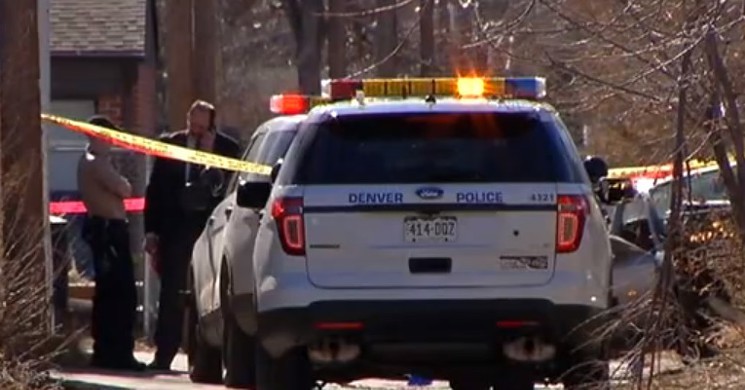In response to this announcement, Qusair Mohamedbhai, the attorney who represents Hernandez's loved ones on behalf of his law firm, Rathod Mohamedbhai LLC, praises the Denver Police Department and the office of Mayor Michael Hancock for the compassion and respect they've shown the family — something that doesn't always happen in officer-involved shootings, he notes. However, he also makes it clear that a court challenge over Hernandez's death on January 26, 2015, remains a very real possibility.
"There is the potential for a lawsuit, always," Mohamedbhai says. "But there has also been ongoing dialogue between everybody, trying to figure out how to make the best of this situation, which is a tragedy."
The two officers who fired shots into Hernandez's vehicle — Gabriel Jordan and Daniel Greene — were cleared of criminal wrongdoing by then-Denver district attorney Mitch Morrissey in June 2015. But a departmental determination has lingered for another year and a half or so, with complicating factors along the way.
Included among them: The Office of the Independent Monitor, one of several agencies to look into the case (including the Department of Justice's Civil Rights Division, whose analysis was requested by Denver Police Chief Robert White), felt that while Jordan's actions didn't violate departmental policy, the evidence in regard to Greene was less conclusive. This objection is noted in a Denver Police Department timeline of events reproduced at the bottom of this post, following a statement from the Hernandez family.
Here's the Denver DA's office account of the events that led to Hernandez's death, along with photos from the scene included with the original document, referred to as a decision letter.
On Sunday, January 25, as we've reported, Jose Carmen Guzman-Bonilla informed authorities that his Honda Civic had been stolen.
That night, Hernandez and four friends, identified only by where they sat in the car (for instance, "FSP" for "front-seat passenger"), drove around to several locations in the Honda — and the lack of consistency in terms of the survivors' memory of where they went is used to attack their credibility as witnesses.
As an example, one of the teens said Hernandez started the car using a screwdriver rather than a key, after which the group "went and picked up weed from Thornton" and visited a McDonald's, where they narrowly escaped notice from a cop — details none of the other occupants mentioned, according to the report.
Around 2 a.m. or 3 a.m. on the 26th, Hernandez parked the car in an alley behind a residence at 2511 Newport Street, and everyone inside fell asleep.
Around 6:30 a.m., a neighbor called police. Initial reports suggested that he'd done so because the people in the car had been playing music loudly, but there's no mention of that in the letter. The document says the man merely reported a "suspicious vehicle" with its windows fogged up.
Officers Jordan and Greene arrived just shy of 7 a.m., parked in the alley and determined that the car had been stolen. Shortly thereafter, one of the teens spotted the police cars and awakened the others. "They're started to get hinked up and moving around a lot," Jordan radioed to supervisors.
Two minutes later, shots were fired.
Jordan's account of what happened states that he turned on the emergency lights of his vehicle, drove closer to the front of the Honda, which was facing him, and yelled, "Police! Get out of the vehicle! Police! Get out of the vehicle!"
At that point, Jordan says, he saw a door on the driver's side of the Honda open and "what looked like a Hispanic male looked back and then ducked his head back in and shut the door."
Next, Jordan told investigators, the Honda backed up slowly toward Greene's police car and either made contact with its bumper or stopped just before touching it.
The Honda then "changed direction and moved slowly northbound" in Jordan's direction, prompting him to repeatedly shout, "Stop! Stop the car! Police!"
Instead, Jordan maintains, the Honda reversed again in the direction of a wooden fence, which it hit along with a trash container.
Jordan says he reacted by moving around his vehicle toward the Honda, running along its side, at which point "the car engine revs up and it comes directly at me...driving right at me at a high rate of speed."
Jordan said the car came within "inches" of him, prompting him to open fire with the gun in his right hand as he pushed away on the fender of the car with his left hand. A quote:
"I waited till I had to hit the car away and I'm thinking now I'm going to go — I'm going to get squished and — and killed, and right then is when I fired. And...I'd be surprised if my gun wasn't touching the driver's side — the window."Greene's separate statement agrees with Jordan's in every significant detail, as does that of a neighbor, Crystal Engler. An excerpt from her statement reads:
"Instead, the car ended up like kind of accelerating, and like — like moving toward the police, like right toward the police and — and I did see an officer get hit, and it was kind of like he bounced off of it — you know what I mean? It was like — like, 'Oh my goodness!'"The witnesses inside the car had different recollections of events. The FSP said "she never saw an officer get hit by the Honda and she did not see an officer in the path of the car," the report states.
The other passengers agree with this basic contention, but the report stresses variations in their statements and the fact that the windows were foggy, perhaps obstructing their views.
From there, the report delves into aspects of the crime-scene investigation, complete with details about the eight bullet holes that punctured the Honda and their trajectories, as well as Hernandez's autopsy results. She had two gunshot wounds to her torso and one to her pelvis and right thigh — "four wound paths that were caused by three bullets," the letter allows.
The analysis determines that "of the eyewitness accounts, the physical evidence only supports the accounts given by the two officers and by Ms. Engler.
"The physical evidence is compelling evidence that Officer Jordan was where he described being when he fired his shots," the account continues. "The fact that the teenage witnesses did not see Officer Jordan there during the undoubtedly frantic and traumatic moments of the shooting is understandable under the circumstances. The teenagers had been consuming marijuana and alcohol, had just awakened from their sleep in a car, and their vision was obscured by the foggy windows."
Based on this information, Morrissey reached the following determination:
In conclusion, after reviewing all of the evidence in this investigation, my judgment is that if a jury were presented with the totality of the evidence, the jury would find from the facts, as I do, that:Immediately after Morrissey's finding, the Denver Police Department announced a change in its policy about shooting into moving vehicles — a tactic that had previously been criticized by Independent Monitor Nicholas Mitchell. The new policy read in part: "Firearms shall not be discharged at a moving or fleeing vehicle unless deadly force is being used against the police officer or another person present by means other than a moving vehicle."
• The officers were lawfully attempting to arrest the driver of a stolen car;
• The officers reasonably believed that the sudden acceleration of the Honda toward Officer Jordan was the use or imminent use of deadly physical force by the driver;
• The officers reasonably believed that responding with deadly physical force was necessary in order to defend Officer Jordan.
These findings would result in a finding that the officers’ use of deadly force was justified under C.R.S. 18-1-707, and therefore was not unlawful.
Similarly, regarding the justification set forth in C.R.S. 18-1-704, I conclude that a jury would find, as I do, that:
• The officers reasonably believed that the acceleration of the Honda toward Officer Jordan was an unlawful use or imminent use of force by the driver;
• The officers had reasonable grounds to believe, and did believe, that Officer Jordan was in imminent danger of being killed or of receiving great bodily injury;
• The officers reasonably believed less than deadly physical force was inadequate to defend Officer Jordan under the circumstances.
These findings would result in a jury finding that the officers’ use of deadly force was justified under C.R.S. 18-1-704, and therefore was not unlawful.
At the time, attorney Mohamedbhai said that had this policy been in place the previous January, Hernandez would still be alive. Today he calls the shift, as well as the change in the DPD's approved procedures for high-risk traffic stops, "a good start. We're looking forward to more."
He also compliments Denver officials for the way they've dealt with the Hernandez family since the shooting.
"Denver has been humane," Mohamedbhai allows. "The day Jessica was killed, the mayor called the father, and they recently had face-to-face meetings. And the mayor called before any of this [the no-discipline decision] came out to let the family know what was going on. And those gestures are appreciated."
They're also far from typical. Mohamedbhai, who has handled numerous high-profile Denver cases involving alleged excessive force and police brutality, including a notorious 2009 incident at the Denver Diner, points out that "the chief of police, the mayor, [Manager of Safety] Stephanie O'Malley: They've all met with the family. And in my experience, that is unique."
White's statement about the discipline determination also underscores compassion. It reads: "The Denver Police Department places great value on the sanctity of life and mourns with the community when a life is lost tragically. When officers must use deadly force, a full review of the incident takes place. After reviewing all of the facts and circumstances of the Jessica Hernandez case, it has been determined that the officers’ actions do not warrant disciplinary action. Nonetheless, this incident is a tragedy for all involved. Ms. Hernandez had her whole life in front of her, and we mourn her loss with the family."
Nonetheless, Mohamedbhai isn't taking a potential lawsuit off the table. "The facts are very complicated and messy," he maintains. "As we go down this path with Denver, we'll see what happens."
In the meantime, an event has been scheduled for Thursday, January 26, to mark two years since Hernandez's passing. It gets under way at the intersection of 25th and Newport, not far from where she was killed. Visit the Honoring Jessie 2nd Year Facebook event page for more information.
Continue to read the aforementioned statement from Jessica Hernandez's family and the DPD timeline.
Hernandez family statement:
Today, the family of Jessica Hernandez received a call from Denver Mayor Michael Hancock, who expressed compassion as he conveyed the results of the Police Department’s internal affairs investigation. This call followed a productive face-to-face meeting on November 16, 2016, where the family and Denver officials, including the Mayor and Chief White, discussed their strong desire to bring positive change from such an inexplicable tragedy. The family has expressed to Mayor Hancock their appreciation for his willingness to grieve and pray with them.
Nevertheless, the Hernandez family will achieve justice for Jessie and continue to advocate for meaningful police reform. DPD’s changed policies on vehicle stops and shooting into moving vehicles will hopefully prevent future tragedies like the killing of Jessie and other members of the Denver community. The Hernandez family will continue to work with the community and Denver to try to bring about positive change and ensure that Jessie’s death was not in vain.
The Hernandez family holds out hope that no other family or community will have to experience their pain. They appreciate the compassion and support that the Denver community has shown as they still try to come to grips with this immense loss. Not a day goes by that they don’t think about and miss their beloved Jessie.
Denver Police Department timeline of the Hernandez case:
June 5, 2015: Denver District Attorney Mitch Morrissey issued a Decision Letter stating that no criminal charges would be filed against the officers. Specifically, the District Attorney concluded that the facts show that the officers’ decision to shoot Ms. Hernandez were justifiable in light of the manner in which she drove the car in close and dangerous proximity to them, threatening the life of Officer Jordan, who had little room to avoid the car.
June 10, 2015: The Internal Affairs Division (IAD) began its internal investigation into the officers’ conduct.
June 19, 2015: The Office of the Independent Monitor (OIM) received a copy of the investigation file for its review.
October 26, 2015: The OIM requested that additional investigation be conducted by IAD.
November 30, 2015: After reviewing the IAD investigation, the Denver Division of the Federal Bureau of Investigation, in conjunction with the Department of Justice (DOJ), did not find sufficient evidence to corroborate the elements of a civil rights violation and, as a result, the DOJ declined to open an investigation. The review was conducted at the request of Chief Robert C. White.
January 27, 2016: The Use of Force Review Board unanimously determined the actions of the officers were within policy. The OIM agreed that the shooting by Officer Jordan did not violate department policy, but did not believe the evidence was conclusive regarding the shooting by Officer Greene. The Use of Force Board also unanimously voted that the case should not be recommended to the Tactics Review Board.
March 31, 2016: The Conduct Review Office (CRO) drafted a Review and Findings Letter and provided it to the OIM.
August 26, 2016: The Denver Police Department was made aware of an allegation being made by a claimed witness to the incident. While the allegations did not involve the conduct of the officers involved in the incident, additional investigation was conducted into the allegations to ensure the investigation was thorough and complete.
January 6, 2017: The CRO issued a Review and Findings report which determined that, given the totality of the circumstances, the officers’ actions were appropriate and necessary because it was reasonable for the officers to believe that the vehicle Ms. Hernandez was driving posed an immediate threat to Officer Jordan’s life, and that, as a result, there was no alternative course of action that could reasonably be taken to prevent death or serious bodily injury to Officer Jordan. Specifically, CRO found that: (1) Ms. Hernandez’s persistent defiance of lawful orders demonstrated a desire and willingness to evade arrest, and her actions in continuing to drive the vehicle to avoid apprehension posed an immediate threat of death or serious physical injury to Officer Jordan; (2) Ms. Hernandez’s intentional repositioning of the car to attempt to escape along the west side of Officer Jordan’s vehicle not only placed him in harm’s way, but showed a conscious disregard for his safety; (3) the increased rate of acceleration away from the fence compared to the slow back and forth movements just moments earlier supports the reasonableness of Officer Greene’s belief that the vehicle posed an immediate threat to Officer Jordan’s life; (4) when Ms. Hernandez turned the Honda to the northwest it placed Officer Jordan directly in the path of the vehicle; (5) the proximity of the car to Officer Jordan as it was moving made it a reasonably perceived threat; (6) the speed of the car suggests it was objectively reasonable to believe the car posed an immediate threat of death or serious physical injury and there was no other reasonable course of action; (7) the officers had a minimal amount of time to perceive the threat from the car and to react to it; (8) the confined space along the west side of the alley for Officer Jordan to maneuver and avoid the car suggests Officer Jordan did not have a reasonable alternative course of action; and (9) there was a high risk of serious injury or death to Officer Jordan if he were run over by the car or if he were crushed or dragged against the brick wall or fence as the vehicle moved.


















